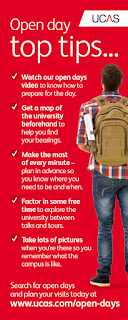It’s always a good idea to get a taste of a university
before you apply there or accept an offer of a place from them. The best way to
do this is by attending an open day! Not sure how to find them or why you
should attend? This blog has it covered…
They give you the chance to get a first-hand impression of the
uni that you can’t get online – so important if you end up spending three years
living there. You’ll get to see the university in action, find out more about the
course, ask the tutors questions as well as the opportunity to meet their students
who will know the uni inside out.
Search for open days
and make a shortlist
There are over 370 unis and colleges in the UK, so you won’t
be able to attend them all! Make a shortlist of the unis and courses you’re
interested in by looking at our search tool.
Once you’ve done that, search for open days on our website.
If the uni doesn’t have any listed, have a look on their website or give them a
quick call to find out if they have any events lined up.
Prepare for open days
The uni will have a planned itinerary that will usually
consist of a tour of the grounds, staff and student talks, and opportunities to
ask questions. Consider what sort of questions you’d like to ask and what
departments you’d like to see before you attend.
Make sure you give yourself plenty of time to arrive as you
don’t want to miss any important info. Most unis will have advice on their
website on public transport links and sat nav instructions to get there so have
a quick look when you plan your journey.
Can’t make it? There
are alternatives
We appreciate that trying to attend numerous open days can
be expensive, tiring, and not always logical. If this is the case then try the
next best thing, our virtual
tours! These shouldn’t be seen as a replacement for open days, just an
alternative if you can’t visit.
Some unis offer taster courses,
which include workshops and seminar sessions led by academic staff. They
provide you with valuable insight into how the university or college works. You
can search for taster courses on our website.









